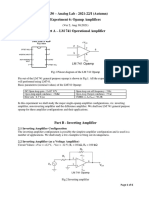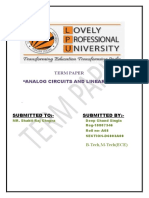Instrumentation Amplifiers: EE 483 Week 4 - Spring 1998
Instrumentation Amplifiers: EE 483 Week 4 - Spring 1998
Uploaded by
ge_bdCopyright:
Available Formats
Instrumentation Amplifiers: EE 483 Week 4 - Spring 1998
Instrumentation Amplifiers: EE 483 Week 4 - Spring 1998
Uploaded by
ge_bdOriginal Title
Copyright
Available Formats
Share this document
Did you find this document useful?
Is this content inappropriate?
Copyright:
Available Formats
Instrumentation Amplifiers: EE 483 Week 4 - Spring 1998
Instrumentation Amplifiers: EE 483 Week 4 - Spring 1998
Uploaded by
ge_bdCopyright:
Available Formats
Instrumentation Amplifiers
EE 483 week 4 - Spring 1998
Introduction:
A common theme in instrumentation deals with how to amplify a small differential signal. Take for example the problem of trying to measure a person's muscle activity. If two probes are placed across a muscle, a small voltage will be generated when the musche tightens (typically on the order of a few millivolts). In order to read this signal into an A/D converter, 1) The signal needs to be amplified to 0-5V (in order to reduce the quantization noise resulting from the A/D process), and 2) The amplifier needs to amplify the difference voltage, rather than amplifying each signal separately and then subtracting. In this section of EE 483, three types of differential amplifiers will be described (1-stage, 2-stage, and 3-stage) along with some differential amplifier IC's. At the end of this week, a student should be able to design a differential amplifier for a given signal. The simplest instrumentation amplifier uses a single operational amplifier (such as an LM741):
R1
R2 V(-) R2 V(+) + Vo
R1
Ideally, the output for this circuit is
V o = R1 (V(+) V()) R2
The input impedance for the two inputs are: R in(+) = R 1 + R 2 R in() = R 2
Notation:
Instrumentation Amplifier: The symbol instrumentation amplifier is as follows: for an
V(-)
Vo
The two inputs, V(+) and V(-), allow you to use this circuit several ways. For example: Problem: Design a circuit which amplifies a signal which goes from (4.1,4.3V) to (0,+5V). Solution: The gain is
V(+)
The output is ideally a gain times the differential input
Vo = k(V + V )
with no gain times the common mode (so that the common mode rejection ratio is infinity). Note that an instrumentaion amplifier has the same symbol as an operation amplifier. While this may cause confusion, you can differentiate between the two by looking for feedback resistors. If there is no feedback, the device in the circuit diagram is probably an instrumentation amplifier. If there is feedback, it's probably an operational amplifier. The circuits to build an instrumentation amplifier are described in the following.
50 gain = R1 = 4.34.1 = 25 R2
Let R1=25k and R2=1k. This gives you the desired spread in output voltages. So that the output increases as the input increases, connect this signal to the V(+) input. To shift the DC level correctly, set V(-) so that Vo=0V with V(+)=4.1V. Hence, the circuit should be
One-Stage Instrumentation Amplifier
5-1
25k
V(-)
+ -
1k 4.1V 1k Signal +
R2 +
R1
Vo
R2 Vo
25k
R1 V(+) +
While this circuit is simple, it has some problems. First, the input impedance is not infinite. If the sensor has a high output impedance (i.e. is not able to drieve a 1k load), this circuit may alter the signal you're trying to measure. Second, it is difficult to adjust the gain of this circuit. Instead of having one resistor you could adjust to alter the gain, you have to adjust two resistors: both R1's or R2's. Third, it is difficult to keep the common mode rejection high. If, for example, the lower 25k resistor were 26k (a 4% change), the amplifier's output becomes
Vo = R1 (V(+) V()) R2
One improvement on this circuit is to add a buffer to the inverting and noninverting inputs. This results in the input inpedance going to infinity (in theory), tens of megaohms in practice. While this solution solves the problem of the instrumentation amplifier loading the input, it still has some problems. First, the gain cannot be adjusted without adjusting two resistors at once. Second, the input stages can saturate. For example, if the power supply is +12V and you're trying to measure a 0.1V differential signal, this amplifier will work if that signal is between 5.1V and +5.2V but not if it is between +20V to +20.1V. Because of this, some chips (such as the AD626) use a divide-by-6 for the input stages rather than a gain of one. This allows a +12V supply to work with signals which are up to +72V without saturating the input stage.
Vo = 26V(+) 25V()
or
Vo = 25.5(V + V ) +0.5(V + + V )
A 4% change in one resistor has resulted in the differential gain changing by 2%, the common mode gain jumping from zero to 0.5, and the common-mode rejection ratio changing from infinity to 51. This sensitivity makes this type of instrumentation difficult to use if a variable gain is desired.
Three-Stage Instrumentation Amplifier
V(-) + Ra R1
One Stage Instrumentation Amplifier withInput Buffering:
R2 Rb Ra R2 + Vo
R1 V(+) +
5-2
In order to allow you to adjust the gain with a single resistor. the above circuit can be used. With this configuration, the gain of the amplifier is
resistor for the AMP04. Further, you can adjust the DC offset by applying a signal to the reference input. The AMP04 was designed for low-power consumption (700uA draw) and operation with single-sided power supplies (such as a single battery). Unlike some operational amplifiers, the AMP04 can be operated from a single power supply (from +5 to +15V), making it applicable to uses such as battery operated sensors. The output is limited to 0V on the low side and the power supply on the plus side, however. To prevent slipping of the signals, the reference input allows you to adjust hte DC level. For example, the following circuit
Vo = R1 1 + Ra (V(+) V()) Rb R2
Note that the overall gain can now be adjusted by tuning a single resistor.
Two Op-Amp Instrumentation Amplifier
Rg R1 R2 R3 R4
V(-) V(+) +
Vo
is a differential amplifier with a gain from 1 to 1000, uses a single +9V supply, and center's the output voltage at 4.5V.
100k
Using two operational amplifiers, you can design a circuit which has high input impedance, as shown above. The problem with this circuit is that i) Common-mode voltages will tend to saturate the first stage, and ii) It is difficult to adjust the DC offset while measuring a differential voltage. In order to overcome the second problem, the AMP04 was designed:
V(-) V(+)
+9
Rg IN(-) IN(+) VAMP04
Rg V+ Vo Ref Vo
Two Op-Amp Instrumentation Amplifier with Input Buffering & Offset Adjust (AMP04)
V(+) R1 Ref Rg V(-) + R2 R2 + R1 Vo
The main problems with the AMP04 is cost (about $10 each). The buffers can also saturate if the common-mode voltage exceeds the power supply.
AD626 Instrumentation Amplifier:
A second amplifier which has proven useful is the AD626. This amplifier usus a divide-by-6 buffer at the inputs allowing the AD626 to work with signals where the common-mode voltage is six times the power supply of the amplifier without saturating its inputs. Its other features include Pin selectable gains of 10 or 100. Pin 7 floating is a gain of 10. Pin 7 grounded is a gain of 100. Single-sided supply range of +2.4V to +10V. Dual-sided supply of to 6V
R V o = R 1 (V+ V ) + V ref g
For the AMP04 IC, R1 = 100k R2 = 11k Rg = external resistor The input buffers have an input impedance on the order of 4G , so this chip will not load the sensor very much. The gain is easilly adjusted by varying Rg - an external
5-3
You might also like
- The Instrumentation AmplifierDocument4 pagesThe Instrumentation AmplifierVinay Atluri100% (1)
- Unit 1. B. Operational AmplifierDocument21 pagesUnit 1. B. Operational AmplifierRonald ConstantinoNo ratings yet
- Lic Lab ManualDocument89 pagesLic Lab ManualKALAIMATHI100% (1)
- Analog Sensor InterfacingDocument5 pagesAnalog Sensor Interfacingkokolanski100% (1)
- Linear Amplifiers and Opamps: I + Av - + V I Z V Z R RDocument19 pagesLinear Amplifiers and Opamps: I + Av - + V I Z V Z R RAnimesh GhoshNo ratings yet
- MAS.836 How To Bias An Op-AmpDocument8 pagesMAS.836 How To Bias An Op-AmpveerasundarNo ratings yet
- Operational Amplifier-IVDocument40 pagesOperational Amplifier-IVBhalchandra ChandakkarNo ratings yet
- Makalah Signal ConditioningDocument64 pagesMakalah Signal Conditioningw4w4n_s3mk4n1s4No ratings yet
- Op-Amps: Experiment Guide: Part 1: Noninverting Amplifier (A) DC MeasurementsDocument4 pagesOp-Amps: Experiment Guide: Part 1: Noninverting Amplifier (A) DC MeasurementsRohini PalanisamyNo ratings yet
- Opamp Lab Assign 1Document9 pagesOpamp Lab Assign 1NareshNo ratings yet
- CH 3sDocument67 pagesCH 3sSantosh GoudarNo ratings yet
- Sensors and ActuatorsDocument43 pagesSensors and Actuatorshitesh reddyNo ratings yet
- Op Amps CircuitsDocument11 pagesOp Amps Circuitslibrian_30005821No ratings yet
- Op AmpDocument40 pagesOp AmpSami KasawatNo ratings yet
- SUMMING AND DIFFERENCEDocument9 pagesSUMMING AND DIFFERENCENYONGESA CephasNo ratings yet
- Chapter 2Document22 pagesChapter 2Anne DiasNo ratings yet
- Lab 1 Operational AmplifiersDocument12 pagesLab 1 Operational AmplifiersChris BrownNo ratings yet
- Experiment 1 Non-Inverting Amplifier 9.1 ObjectiveDocument7 pagesExperiment 1 Non-Inverting Amplifier 9.1 Objectiveyoungdiana023No ratings yet
- Lectures 16 To 18 - Op-AmpDocument19 pagesLectures 16 To 18 - Op-AmpAniketsingh MundlothNo ratings yet
- EE 230 - Analog Lab - 2021-22/I (Autumn) Experiment 6: Opamp AmplifiersDocument6 pagesEE 230 - Analog Lab - 2021-22/I (Autumn) Experiment 6: Opamp AmplifiersSruthiNo ratings yet
- Exp 02 CSE251 Fall 2024Document8 pagesExp 02 CSE251 Fall 2024sujailyunus84No ratings yet
- Experiment - 05Document17 pagesExperiment - 05Sagar SharmaNo ratings yet
- Lab 1 Operational Amplifiers: The Basics: Labview Demo 1.1: Op-Amp GainDocument8 pagesLab 1 Operational Amplifiers: The Basics: Labview Demo 1.1: Op-Amp GainSarath ChandraNo ratings yet
- Advanced Electronics Lab ManualDocument88 pagesAdvanced Electronics Lab ManualsmganorkarNo ratings yet
- Exp No8Document9 pagesExp No8Mohd Syamsul Ramli100% (1)
- Electronics-2 Lab Report 7Document7 pagesElectronics-2 Lab Report 7siyal343No ratings yet
- Simple Op Amp Measurements: by James M. BryantDocument3 pagesSimple Op Amp Measurements: by James M. BryantFer TgNo ratings yet
- Final Op Amp Lab ReportDocument7 pagesFinal Op Amp Lab Reportmehrin12367% (3)
- Term Paper: "Analog Circuits and Linear Ic'S"Document17 pagesTerm Paper: "Analog Circuits and Linear Ic'S"Deep Chand SinglaNo ratings yet
- Chapter 6 - OpAmpDocument7 pagesChapter 6 - OpAmpOm PrakashNo ratings yet
- Lecturenote - 380017715exp 1 Introduction To IC 741 and IC555, Inverting AmplifierDocument10 pagesLecturenote - 380017715exp 1 Introduction To IC 741 and IC555, Inverting AmplifierHarivony AndriamanantenaNo ratings yet
- The "Operational" Amplifier: Eng - Ahmed HeskolDocument27 pagesThe "Operational" Amplifier: Eng - Ahmed HeskoladilNo ratings yet
- Op-Amp Lab KitDocument44 pagesOp-Amp Lab KitQodor MubarakNo ratings yet
- Inverting AmplifierDocument9 pagesInverting AmplifierKenzie WalipiNo ratings yet
- Basic Feedback Theory: Integrated CircuitsDocument5 pagesBasic Feedback Theory: Integrated CircuitsSourik BharNo ratings yet
- Top 10 Fundamental Operational Amplifiers CircuitsDocument7 pagesTop 10 Fundamental Operational Amplifiers CircuitsNguyễnVănTuấnNo ratings yet
- Op-Amps: I. Practical Op-AmpDocument7 pagesOp-Amps: I. Practical Op-AmpSteven Nelson100% (1)
- LIC LAB REPORT NewDocument27 pagesLIC LAB REPORT NewWINORLOSENo ratings yet
- Operational Amplifiers I: Experiment 11Document4 pagesOperational Amplifiers I: Experiment 11asmonovNo ratings yet
- Ecgr3155 Experiment 8 Mosfet Amplifiers Configurations and Input Output ImpedancesDocument9 pagesEcgr3155 Experiment 8 Mosfet Amplifiers Configurations and Input Output ImpedancesdrhammoudaNo ratings yet
- S.No Particulars Specifications Range QuantityDocument11 pagesS.No Particulars Specifications Range QuantityVijayakumar KNo ratings yet
- Lab 9Document5 pagesLab 9gratz_redobleNo ratings yet
- Operational Amplifiers (Op Amps) : Voltages. Symbol For An Op-AmpDocument8 pagesOperational Amplifiers (Op Amps) : Voltages. Symbol For An Op-AmpRaymond ScottNo ratings yet
- Lab 8 Operational Amplifier Applications II: PurposeDocument4 pagesLab 8 Operational Amplifier Applications II: PurposeAlexandreNo ratings yet
- Lab Manual: Subject: Integrated Electronics BE 6 Section B Submitted byDocument25 pagesLab Manual: Subject: Integrated Electronics BE 6 Section B Submitted byIqraJahanNo ratings yet
- Amplifier A PrelabDocument7 pagesAmplifier A Prelabatomking73No ratings yet
- Electronics Tutorial About Operational AmplifiersDocument8 pagesElectronics Tutorial About Operational AmplifiersexploreodysseyNo ratings yet
- Operational Amplifier Basics - Op-Amp TutorialDocument8 pagesOperational Amplifier Basics - Op-Amp TutorialGaneshVenkatachalamNo ratings yet
- Applications of Op-AmpDocument35 pagesApplications of Op-AmpKalpana KoppoluNo ratings yet
- Reference Guide To Useful Electronic Circuits And Circuit Design Techniques - Part 1From EverandReference Guide To Useful Electronic Circuits And Circuit Design Techniques - Part 1Rating: 2.5 out of 5 stars2.5/5 (3)
- Reference Guide To Useful Electronic Circuits And Circuit Design Techniques - Part 2From EverandReference Guide To Useful Electronic Circuits And Circuit Design Techniques - Part 2No ratings yet
- Easy(er) Electrical Principles for General Class Ham License (2015-2019)From EverandEasy(er) Electrical Principles for General Class Ham License (2015-2019)Rating: 5 out of 5 stars5/5 (1)
- Design of Electrical Circuits using Engineering Software ToolsFrom EverandDesign of Electrical Circuits using Engineering Software ToolsNo ratings yet
- Easy(er) Electrical Principles for General Class Ham License (2019-2023)From EverandEasy(er) Electrical Principles for General Class Ham License (2019-2023)No ratings yet
- RTD Microchip AN687A - Pt100Document8 pagesRTD Microchip AN687A - Pt100ge_bdNo ratings yet
- 6-Pin Dip Random-Phase Optoisolators Triac Driver Output (250/400 VOLT PEAK)Document10 pages6-Pin Dip Random-Phase Optoisolators Triac Driver Output (250/400 VOLT PEAK)ge_bdNo ratings yet
- Medium Voltage2Document3 pagesMedium Voltage2ge_bdNo ratings yet
- Temperature and Humidity Module: DHT11 Product ManualDocument9 pagesTemperature and Humidity Module: DHT11 Product Manualge_bdNo ratings yet
- LH SeriesDocument4 pagesLH Seriesge_bdNo ratings yet
- The TRIAC - ThyristorsDocument3 pagesThe TRIAC - Thyristorsge_bdNo ratings yet
- AN2097 Application Note: Vipower: 10W Power Smps Using Viper22A For Air-Conditioner ApplicationDocument8 pagesAN2097 Application Note: Vipower: 10W Power Smps Using Viper22A For Air-Conditioner ApplicationAbubakar SidikNo ratings yet
- How-To-Get-Your-Boss-Fired - Personal Finance News From Yahoo! FinanceDocument3 pagesHow-To-Get-Your-Boss-Fired - Personal Finance News From Yahoo! Financege_bdNo ratings yet
- P521Document3 pagesP521ge_bdNo ratings yet




































































